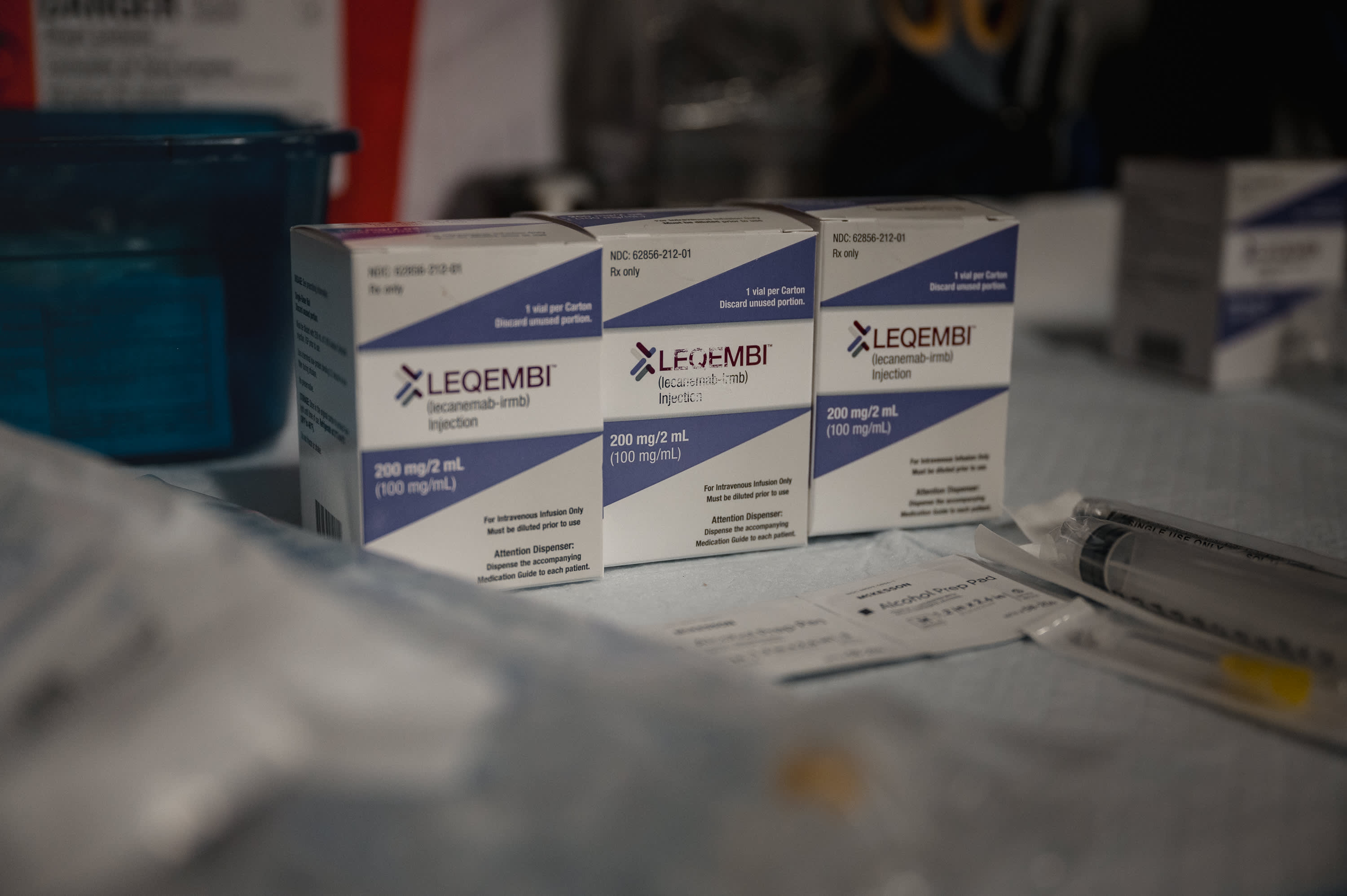
The newly FDA approved Alzheimer’s treatment Leqembi is prepared at Abington Neurological Associates in Abington, PA., on Tuesday, November 7, 2023.
Hannah Yoon | The Washington Post | Getty Images
The breakthrough Alzheimer’s drug Leqembi slowed disease progression in patients over three years, demonstrating the need for them to stay on the treatment long term, according to new data released Tuesday by Japanese drugmaker Eisai.
The study results on Leqembi, which Eisai shares with Biogen, also found that a patient’s Alzheimer’s disease worsens after they stop treatment. Rates of adverse side effects associated with Leqembi, including brain bleeding and swelling, dropped after six months of treatment, Dr. Lynn Kramer, Eisai’s chief clinical officer of deep human biology learning, told CNBC.
That decline is critical: Those side effects in the brain have raised concerns among some doctors and are the main reason a European drug regulator recommended against approving Leqembi last week.
The study is the longest available efficacy and safety data to date on Leqembi, which has had a bumpy rollout in the U.S. since winning regulatory approval last summer due to bottlenecks related to diagnostic test requirements and regular brain scans, among other issues. Eisai released 24-month data on Leqembi in November.
Eisai presented the findings on Tuesday at the Alzheimer’s Association International Conference in Philadelphia, the world’s largest meeting for dementia research. The results are a first glimpse at what Alzheimer’s patients’ future could look like on therapies such as Leqembi, which is currently taken twice a month through an infusion.
The drug is a monoclonal antibody that targets toxic plaques in the brain called amyloid, a hallmark of Alzheimer’s, to slow the progression of the disease during its early stages. Leqembi also works by clearing protofibrils, the building blocks of amyloid plaque.
The data demonstrates the importance of early and sustained treatment for people living with the notoriously hard-to-treat brain disorder — even after a drug clears a patient’s amyloid plaque.
“Continuing treatment is important if you would like to maintain cognition and functionality longer,” Kramer said.
While Leqembi is not a cure, “if you start early enough, it can give you years of benefit,” he said.
Kramer added that Eisai believes patients can eventually switch to a maintenance dose of Leqembi after roughly 18 to 24 months of treatment, which could be a less frequent or more convenient way to take the drug over a long period.
Eisai and Biogen are seeking regulatory approval for a once-monthly infusion of Leqembi, with a decision expected in January. The drugmakers also aim to bring to the market an injectable form of Leqembi that patients can take at home once a week.
“Those two things will change the paradigm, make it easier for the patient, make it easier for the whole medical system,” Kramer said in an interview.
Nearly 7 million Americans have the condition, the fifth-leading cause of death for adults over 65, according to the Alzheimer’s Association. By 2050, the number of Alzheimer’s patients is projected to rise to almost 13 million in the U.S.
Long-term study details
The results are based on extended research on certain participants in mid-stage and late-stage trials on Leqembi.
One phase three trial, called Clarity AD, examined three different groups of patients for 36 months.
One group of participants took Leqembi for the full three years, while another received a placebo for the first 18 months before switching to Eisai’s drug for the same length of time. Eisai observed a last group of patients outside of the trial who did not receive any treatment over three years.
Tek Image/science Photo Library | Science Photo Library | Getty Images
Patients who started Leqembi early continued to benefit from the drug over three years, showing a slower rate of cognitive decline compared to the other two groups, according to an Eisai presentation.
The difference in cognitive decline between the “early start” Leqembi group and patients who did not receive anything throughout the study period grew larger between 18 and 36 months, according to Kramer.
Leqembi “interrupts the natural progression of the disease, and it has an effect more and more,” he said, adding that “the earlier you catch it, the better.”
Patients who started on a placebo saw a slower rate of cognitive decline after switching to Leqembi at the 18-month mark. But their Alzheimer’s disease was still worse than the group that started Leqembi earlier through the 36 months.
A sub-study of the trial partly examined patients with no or very low levels of another protein that builds up in the brain called tau, which is considered a marker of Alzheimer’s severity. People with low levels of that protein are at the earlier stages of the disease.
After three years on Leqembi, 59% of people with no or very low tau levels did not see their Alzheimer’s progress at all, according to the presentation. A little over half of that patient population actually saw their condition improve.
Meanwhile, one phase two trial, called Study 201, examined patients who temporarily stopped treatment with Leqembi.
For 18 months, one group of participants took Leqembi and another received a placebo. The groups then took nothing during a gap period of two years on average before all patients started treatment with Leqembi for another 18 months.
Leqembi’s positive effect on a patient’s disease was maintained even after they stopped treatment, according to the presentation.
But the rate of cognitive decline in patients who stopped Leqembi reverted to the rate of people who had taken a placebo during the gap period. That shows that even when amyloid plaque is removed, the disease continues to progress when a patient stops Leqembi, Eisai said in a release.
“The concept is, if you stop, you get worse,” Kramer said.
This article was originally published on CNBC

